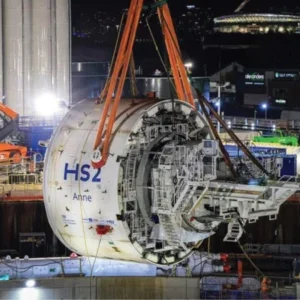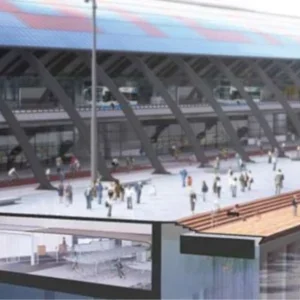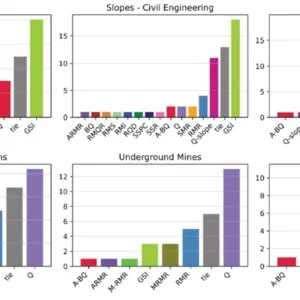
For credit ratings agency Standard and Poor’s (S&P), the seeming belief among financial and other public-private partnership (PPP) players that tunnelling is inherently, even characteristically, a far higher class of risk than any other type of construction came out of left field.
The perception leapt out from an S&P survey of PPP clients and the supply chain, and it has S&P doing some digging of its own. But inclusion in a shortlist of the rogues of risk will not sit lightly with tunnellers, who will wonder how this perception reflects progress made in risk management.
For there are Risk Registers produced, and arguably more importantly, maintained by project teams to the wishes of insurers, at least. The registers help implement the Code for risk management in tunnels (see box; Road to the Code). A similar Code is being rolled out internationally, though its reception in the US has a way to go. There, risk in tunnelling is tackled using a powerful set of specifically developed tools to identify and share risk, i.e, Geotechnical Baseline Reports (GBRs), which are supported by Dispute Review Boards (DRBs).
So, what could get the PPP players to pan tunnels so badly as an asset class? It will be of concern with the boom in PPP projects. Billions of dollars worth of transport infrastructure schemes are conceived for Europe alone. Delegates at the ITA-AITES World Tunnel Congress, in Prague, heard last month from The European Investment Bank that the list is growing. For instance, major road PPPs in Greece involving tunnels have been awarded to JVs led by Vinci and Hochtief. Farther afield, in Australia, excavation is underway on the privately financed Brisbane North-South bypass.
Survey outcomes
In terms of construction risk, the S&P survey asked if the PPP players link it to an asset class? The respondents’ experience of construction risk was mainly in the characteristics of project mandates – except for tunnels, which they volunteered.
S&P’s researchers were ‘surprised’, given their familiarity with the sector. They are widening the survey for greater statistical significance, and more participation is wanted from the construction industry, and not only from the big names.
While the agency plans extra research, T&TI was told it did garner useful, practicable intelligence from the survey, enough to produce its own Construction Risk Index (CRI). In the index, grades are awarded on categories of risk on projects, including: preparations; characteristics; concession agreement; private sector; public sector; and, political and regulatory risk. Each has four to 14 sub-categories.
S&P will use the index to systematically test the data and information produced in projects. Already it has been applied to a road tunnel project in northern Europe, but details were not disclosed.
Going further, S&P is to use the index to grow a body of institutional intelligence with which it will study projects more comprehensively and pronounce on risk. It contrasts this approach with usual research efforts, which has a political focus or looks at single projects. The dearth of real-world research led to the survey, which returned 161 responses from 22 countries. On tunnels, S&P cites about 100 responses; 300 are needed for the refined research.
Key people
One category in the index, which had thrown up the most concern among survey respondents as posing construction risk, in general, to PPP projects was the ‘public sector’. S&P says the problems for the supply side can come from a weak buy-in to the very notion of PPPs. Resistance comes from individuals, and they form a culture. The agency added that the ‘nature of the people involved’ in project delivery – the leadership, the individuals – also ‘popped out’ from the survey as being important, and so will become a metric for judgement of projects. The involvement of particular engineers and managers, therefore, will influence the risk profile and so the credit rating of projects, T&TI was informed.
All parties will be scrutinised more for how they contribute to risk sharing. Such knowledge cannot but become part of the information flow, for everyone knows pass the parcel isn’t a risk sharing game.
Sharing information
In promoting risk sharing, the tunnelling industry disseminates information on the ground in projects, of course, but also increasingly at gatherings such as the WTC and RETC conferences. There are other, one-off meetings, too. Yet, the risk theme is not a major feature of the events.
When risk is raised as a business context, such as PPP, the approach has been towards broad coverage, often addressing aspects of project finance as would be typical of most kinds of privately financed infrastructure schemes.
Geotechnical risk is mentioned among many kinds. That others are covered is not inappropriate, witness how toll concessions can suffer due to early traffic risk gone wrong, such as for the Cross City and Herren tunnels. Indeed, there can be other difficulties, such as the extra costs and payment issues for Metronet working to upgrade part on the London metro network. All have hurt JV partners.
Fresh insights into financial modelling can also be gained; for example, many will be familiar with using a discount interest rate to help work out net present capital costs of project alternatives, but not all will be briefed on using multiple rates married to different project phases where risk profiles shift. When looking at cashflow in concessions, this becomes more important.
Perhaps the macro-picture approach to risk briefings in business forums at events is understandable, and for three reasons, possibly. First, the prime focus of the gatherings is to share technical experience through case studies, which both explicitly and implicitly inform risk management. Second, the body of evidence on practical application of new risk management rigour in the new, insurance-inspired milieu is still accumulating, and is yet to reach critical mass. Third, as every project is unique, solutions are not necessarily, or advisably, replicable. Still, the Q&A is usually where the learning happens. Getting in too deep could be counter-productive, even if commercial confidentialities, or corporate sensitivities, were allowed in PPP-related discussions.
Vinci Concessions’ director of strategy and development on projects, Vincent Piron, spoke in Prague. he told T&TI: ‘It’s been a kind of learning curve for everybody.’ He added that when discussing PPP and tunnels you ‘cannot generalise, as risks are project- and time-specific’.
Specifics, though, have been prone to spawn contractual clauses, which has tormented generations of engineers and fed the adversarial culture in construction. That ‘for sure is not the right solution’, as consulting engineer Giovanni Lombardi observed in 2001 at the ITA’s Open Session on Project Financing, in Milan.
But now, with lawyers instructed to help optimise risk sharing in procurement, that world is changing. Piron told T&TI the change has been observable within only a few years, helped by constructors’ moves to accommodate the lump sum rationale as the baseline for risk sharing agreements. As a consequence, lenders also have been changing position. Recently, he says, one lender told him it had decided to become more involved in PPP, including tunnels.
How tunnelling was working with the financial sector had to change given the costly claims from collapses. Insurers demanded, and got, new risk management systems (see; Road to the Code).
Progressive steps
Changes were already afoot though, on a project-by-project basis, led by some innovative private sector clients and also to overcome some problems.
In Continental Europe, for example, Piron recalls the landmark event being in the early 1990s when a boulder stopped a TBM on the bypass tunnel in Lyon, France. The client had pushed most risk onto the private sector with a lump sum contract, but the ground conditions were unforeseen. A mind shift preceded the boulder’s removal and the job went on with a deal on extra costs.
‘It was a key turning point,’ Piron recalls. He says it showed that if payment could be handled differently on a lump sum contract, then so, too, could risk. Lump sum could move on from being the deal to the cornerstone of a relationship.
In the UK there were a series of developments. Thames Water, a private client, experimented with IChemE forms of contract on the Ring Main, and that led to the ‘target cost’ incentive approach, which split savings or cost over-runs.
Following the collapse at the Heathrow Express rail tunnel at the airport, the private client BAA changed the contract structure to have the parties work more closely, and with shared objectives. What also helped was the project having being founded upon the relatively more co-operative NEC form of contract. There was also a shift from lump sum to a cost reimbursable deal, with any cost over-runs being shared.
On the Channel Tunnel Rail Link (CTRL), further developments in contractual relationships saw the use of a target price system via NEC with shared costs or savings. This time, though, risk management weighed in on the pre-construction phase to focus on planning, value engineering, constructability and early procurement steps. A further feature was self-certification, with ties, to encourage quality, transparency, diligence, communication and momentum. It was a further step in creating a continuous improvement culture.
BAA’s approaches to procurement featured again at Heathrow, this time for the Terminal 5 project. Strategic partnering led to integrated tasks teams, such as for the Airside Road Tunnels and rail links. A nest of documents stood in place of a traditional contract, and target costs featured.
The Highways Agency is supporting target costs and also fostering ‘early contractor involvement’, such as for the A3 Hindhead tunnel. It, too, is seeking out supply teams with strong relations while pushing design responsibility to constructors.
But such clients and most constructors are not the only ones wanting in early on a project’s development. T&TI was told that insurers are keen to participate earlier to more accurately match their premium quotes to the scope of projects. ‘We are seeking a true partnership,’ Heikko Wannick, underwriter, risk engineer and consultant with Munich Re, says. ‘We want to be involved in the whole process, ideally as early as possible.’
Client views
Some engineers who worked on the Taiwan High Speed Rail (THSR) project also advocate design being actively managed by constructors, if the elected procurement method allows. But such proposals also depend on the outlook of a client, its need or desire for control.
Clients can become far more prescriptive, such as in the US with some ‘Means & Methods’ scoping. If set down too rigidity, constructors can have little to say but a price. TBMs have even been chosen before the tender stage on some projects. While some engineers have noted the system might offer some benefit during bidding, it does not necessarily lower risk for clients, others have argued.
Conversely, if a client has an eye on whole life costs they might want to distance themselves from an asset, leaning instead to rent, preferably for a fixed fee. While common in Europe, such procurement is starting in the US, such as with the Port of Miami tunnel with the Bouygues-led JV.
But even when JVs bring a wealth of experience from other PPP projects, the constructor usually doesn’t start to see improvement in its cashflow until muck moves. And, if parts of the payments, from a concessionaire company or other client, aren’t to be lost over quality problems then some kind of inspection and testing plan (ITP) should be in place and earning its keep – especially with the trend towards more self-certification. Quality needs to be craved, and increasingly there is no walking away for the supply side, for decades.
Relationships
Yet, switching procurement methods, whether to Design-Build or PPP, is not a panacea for the ills of risk management in tunnelling. Neither can efforts to implement target cost, or ‘cost-plus’, contracting alleviate the risk problem despite its increasing popularity. Those may be discussed in various forums but they are frameworks. Within their bounds, success is a consequence of what people do when they work together.
Like on the Lyon bypass and the collapses at the Heathrow Express and the Nicoll Highway in Singapore, where problems need to be fixed and work moved ahead, it is those onsite who get things done if allowed, or don’t if there are hindrances or competing priorities, pulls and restraints.
What happens depends on the culture on a project. No amount of documentation and systems, even Codes, can enforce genuine co-operation. What is really in place on a job will come out. It always does.
On Sijtwende tunnel, in The Netherlands, getting contractual relationships to work on the PPP project demanded great time and effort, especially as roles were unfamiliar. Experience takes time to win, like Piron says. There is no script for PPP but what can be shared to minimise business risk can include technical systems for managing risk in live underground operations. At Prague, delegates heard some described, including:
- process controls for data management in shield drives to help speed decision-making, as used on Line 9 in Barcelona;
- geological prediction ahead of a TBM bore on a tube for the Miyazu No 12 Tunnel, Japan, combining drill logs, drive data and spoil measurement, in real-time;
- use of designated ‘NATM Engineers’ at Dulles airport, during all excavation and support works, following a previous collapse and there being little NATM experience in the US.
Delegates also heard Geodata outline the implementation of Risk Management Plans (RMPs) on road and rail projects. But while RMPs help decision-making during both the design and build stages, delegates were advised that success ‘requires a risk management culture from all the Actors in all phases of the project’. Or, as S&P told T&TI, ‘construction risk is as much about people as plant and machinery’.
The need for positive relationships in teams, and hence on projects, was echoed by A Thomas and JP Banyai at the conference. They also observed that CDM rules in the UK helped to forge teams by both encouraging and enforcing risk-based designs. Risk management is not a set of rules or philosophy to such groups but more a way of thinking and acting. A culture. As a result, formal documentation with supporting workshops and live risk registers may not always need to be operated on a continual basis, the speakers ventured. Instead, a ‘soft’, more ad hoc approach could work, calling on the tools as necessary rather than to schedule.
That call, of course, requires significant engineering experience and judgement in such a team that will be immersed in the job. The group, therefore, is the real risk management tool. All else is support. S&P sees as much, it seems, recognising now more than ever the critical value of staff delivering a project.
Developing engineers
There would appear to be a case that more energy, resource and support needs to be invested in the professional development of greater numbers of individuals, at least that given to management systems, tools and Codes. Otherwise, too much weight on the latter can feel like imposition on the unready or unwilling, and too little attention to the former may leave good staff spread thin or the wrong people in place, and either increases risk.
The industry knows if it has enough skilled and experienced tunnellers, and financial backers will increasingly arrive at similar conclusions. They’re building their own databases. ‘One of the risk mitigants is having good calibre individuals,’ S&P says.
For a long time, leadership in procurement and contracts rested with non-technical advisers from the worlds of law and accounting. As the land shifts under project financing, in the world of PPP they may no longer hold quite so much sway; financiers are coming to see more of the economic value that engineers provide through active risk management. Assuming the tunnelling industry pays attention, then the pendulum could be swinging back towards engineers, by a few degrees at least.
Road to the Code
A few years ago, concern over the rising number of tunnel collapses and the financial pain for insurers led to talks with the tunnelling industry. As a result, BTS and the Association of British Insurers (ABI) developed The Joint Code of Practice for Risk Management of Tunnel Works in the UK, in 2003.
The insurance sector, led by the International Association of Engineering Insurers, worked with ITA to modify the Code for international markets. The new Code came out in 2006 from the International Tunnelling Insurance Group (ITIG), and the number of translations in growing, including German and Chinese, which helped on Shanghai projects.
But, as ITA and ITIG recognise, not all provisions, or approaches, contained in the the international version are easily adaptable, or necessarily legal, everywhere. Local adoption needs amendments, and the will to employ what may be a comparatively new system of risk management.
In the US, the GBR system is an essential ‘administrative tool’ to help keep the playing field level in risk sharing deals by determining who will bear costs. This should implement a fair contracting process and so get insurers to underwrite a tunnel project, Randall J Essex, head of tunnelling with Hatch Mott MacDonald, has said.






